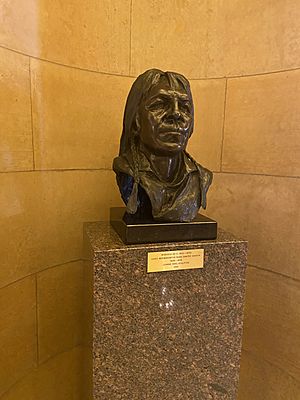Wabasha III facts for kids
Wabasha III (born around 1816, died 1876) was an important leader of the Dakota Sioux. He was also known as Joseph Wabasha. He became the main chief of the Mdewakanton Dakota in 1836, taking over from his father.
After the Dakota War of 1862, the Dakota people were moved to the Crow Creek Reservation. Wabasha then became known as the main chief of the Santee Sioux. In his later years, Chief Wabasha helped his people start new lives at the Santee Reservation in Nebraska.
In 1862, Wabasha did not support the Dakota uprising from the beginning. He tried to get others to agree with him. Towards the end of the conflict, Wabasha, along with Wakute II and Taopi, sent messages to Colonel Henry Hastings Sibley. They told him they did not support Little Crow and offered to help the U.S. Sadly, Wabasha's son-in-law, Hdainyanka, was among those who died in Mankato, Minnesota on December 26, 1862.
In 1986, a special statue of Chief Wabasha III was placed at the Minnesota State Capitol.
Becoming a Chief
Before he became chief in 1836, Chief Wabasha III was called Tatepsin. This name means "Upsetting Wind" or "Bounding Wind."
Chief Wabasha II, Wabasha III's father, passed away during a smallpox epidemic. This illness caused many deaths in his Kiyuksa (Keoxa) group.
Around the time Tatepsin became chief, his Kiyuksa group was twice as large as any other Mdewakanton group. The Kiyuksa group often moved between the mouth of the upper Iowa River and Lake Pepin. They also hunted on both sides of the upper Mississippi River.
Wabasha had many family connections to traders and settlers in the area. In 1842, Chief Wabasha III convinced Amos Bruce, a government agent for Native Americans, to hire his relative, James Reed.
Important Agreements
On September 10, 1836, Tatepsin signed the fifth Treaty of Prairie du Chien. He signed this agreement with Colonel Zachary Taylor, who was acting as a government agent. This treaty gave all Sioux claims to what is now northwest Missouri to the United States.
Chief Wabasha also signed treaties in 1851 and 1858. These agreements gave the southern half of what is now the state of Minnesota to the United States. These land sales meant his group had to move to a special area, called a reservation, along the Minnesota River.
Moving to New Homes
After the conflict, the Dakota people were moved from Minnesota to the Crow Creek Reservation in Dakota Territory.
Later, they moved again to the Santee Reservation in Nebraska. Chief Wabasha passed away there on April 23, 1876.




